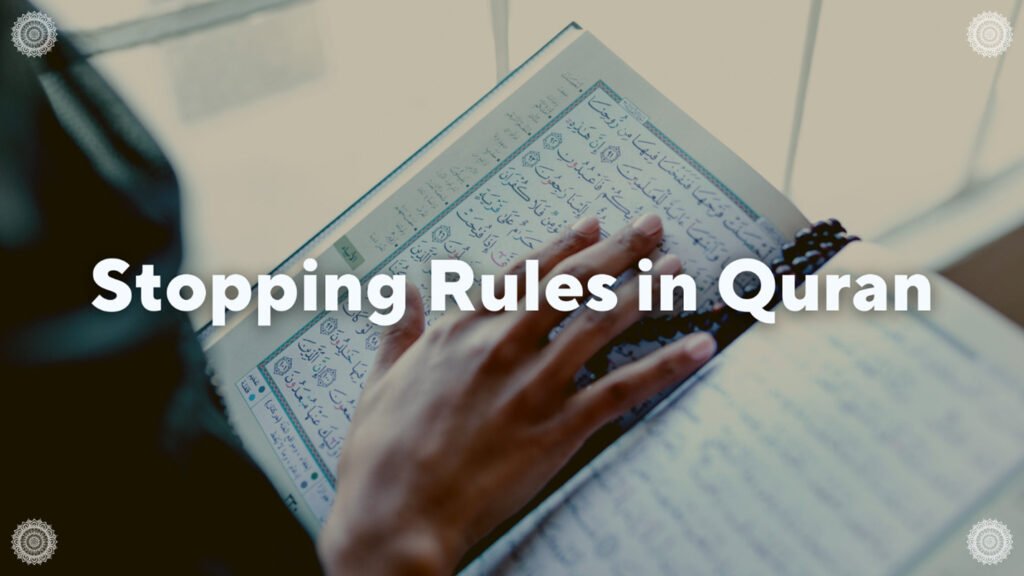Stopping rules in Quran offer some sort of manual that serves to guide the reader to better understand the meaning of the verses. Otherwise, a reader would stop after the word (يستحيي) in the verse: (إن الله لا يستحيي أن يضرب مثلاً) which outrageously changes the meaning of it and makes it inappropriate.
Hence, this article promises to give you a clear and concise explanation of Quran stop signs with examples. So let’s first define the concept of stop or Waqf itself.
Meaning of Waqf or Stopping
The Arabic word for stopping is Waqf (وقف). To apply Waqf while reciting Quran one needs to acquire the knowledge of certain symbols to understand when to stop for some time to take a breath before resuming the recitation. This Waqf or stop can be at the end or in the middle of a verse but it cannot be in the middle of a word.

For example, the verse: (ختامه مسكۚ وفي ذلك فليتنافس المتنافسون) has a stop sign following the word (مسك) which guides the reader that they can either stop here to take their breath or continue their recitation.
Thus, learning rules of stopping in Quran is essential to improve your recitation of Quran and also give you a better understanding of the meanings of Quranic verses so that you can recite quran beautifully.
Stopping Rules and Signs in Quran
For the purpose of learning rules of stopping when reading Quran, one is required to know the meaning of the main stop signs in the Quran. Here are the six common Quran-stopping symbols:

1. Waqf Lazim/ مـ (وقف لازم):
This sign refers to mandatory stop which means that the reader must stop the recitation; otherwise, the meaning will differ. An example of waqf Lazim in quran is the verse:
(لَعَنَهُ اللهۘ وَقَالَ لَأَتَّخِذَنَّ مِنْ عِبَادِكَ نَصِيبَاً مَفْرُوضَاً)
In accordance with stop rules in the Quran, one must stop reciting on reaching this sign so as not to change the meaning of the verse.
Note: Pay attention that there are two symbols in the Quran that take different shapes of the letter Meem. This symbol (م) refers to another rule which is Iqlaab that was mentioned in the article on Noon Sakinah and Tanween rules. Meanwhile, the symbol (مـ) is a sign of a compulsory or mandatory stop.
2. Waqf mamnu’/ لا (وقف ممنوع):
This symbol takes upon the word for “No” in Arabic and it refers to the prohibited stop. This means that the reader cannot stop but must continue their recitation as a stop will completely change the meaning of the verse.
An example of the prohibited stop in Quran is:
(الّذَينَ يُنفِقُونَ أَمْوَالَهُمْ فِي سَبِيلِ اللهِ ثُمَّ لَا يُتْبِعُونَ مَا أَنفَقُوا مَنَّاً وَلَا أَذَىۙ لَهُمْ أَجْرُهُمْ عِندَ رَبِّهِمْ وَلَا َخَوْفٌ عَلَيْهِمْ وَلَا هُمْ يَحْزَنُون)
3. Waqf Ja’iz/ ج (وقف جائز):
When the reader sees the symbol of the letter Jeem, this means that they have the choice to either stop or continue the recitation without one being preferred over the other. This Waqf is found in the Quran in verses like:
(أَوَلَمْ يَرَوا إِلَى الطَّيْرِ فَوْقَهُمْ صَافَّاتٍ وَيَقْبِضْنَۚ مَا يُمْسِكُهُنَّ إِلَّا الرَّحْمَن)
4. Waqf Hassan/ صلى (وقف حسن):
This sign also refers to an optional stop in Quran but it is preferable to continue reciting the rest of the verse. An example of this from the Quran is:
(الذِي خَلَقَ سَبْعَ سَمَاوَاتٍ طِبَاقَاً ۖ مَا تَرَى فِي خَلْقِ الرَّحْمَنِ مِنْ تَفَاوُت)
5. Waqf Kafi/ قلى (وقف كافٍ):
The fifth of the Quran stopping symbols is the opposite of the previous one. The reader is given the choice of either stopping or continuing but stopping is more preferred. Here is an example of Waqf Kafi:
(ما ننسخ من آية أو ننسها نأتِ بخير منها أو مثلها ۗ ألم تعلم أن الله على كل شيء قدير)
6. The embracing stop/ (تعانق الوقف) ∴
This sign is found on two words in the verse and this means that you can stop at either one of the two words but cannot stop at both. In this verse:
(ذَٰلِكَ الْكِتَابُ لَا رَيْبَ ۛ فِيهِ ۛ هُدًى لِّلْمُتَّقِينَ)
There is a sign on the word (ريب) and the word (فيه) and this means that it is permissible to stop after the first word or to continue reading and stop after the second one. However, one cannot stop after both of them.
rules of Sakta in Quran
After listing the six stop signs in Quran, there is still some points to mention. The first being the rule of Sakta in Quran. By Sakta, we refer to a shorter stop than the one resulting from Waqf. This occurs in the Quran in certain verses that have the symbol (س) such as:
(الحَمْدُ لِلهِ الذي أَنْزَلَ عَلَى عَبْدِهِ الكِتَابَ وَلَمْ يَجْعَل لَهُ عِوَجَا ۜ )
(وقيل من ۜ راق)
(قالوا يا ويلنا من بعثنا من مرقدنا ۜ )
Significance of Stop Signs in Quran
Knowing where to stop and pause in Quran demands sufficient knowledge of the Arabic language as well as Tafseer in order to deliver the intended meaning of the verses of the Quran without altering them.
However, these demands could be somehow challenging and for that Quran stopping symbols were made by scholars to make the recitation of the Quran easy as it requires a certain control of breathing.
Stop signs in Quran are said to fulfill a similar role to traffic signs in the street as they guide the reader during his/her recitation on when stopping is obligatory, prohibited or optional.
Also, these signs are significant as they help to preserve the meanings of the Quranic verses from changing in case the reader stops and resumes the recitation from a point in the verse that could completely alter the intended meaning.
Failing to follow the guidelines provided by these stop signs in Quran could lead to give either an incomplete meaning or a false meaning of the verse. Here are few examples to further illustrate this point:
- Incomplete meaning: if the reader stops after the word (رَبّ) in the verse: (الْحَمْدُ لِلهِ رَبِّ العَالَمِين), the meaning is only partially delivered and the reader needs to continue reciting without a pause or stop.
- False meaning: if the stop was made after the word (فَأَكَلَهُ) in the verse: (وَتَرَكْنَا يُوسُفَ عِندَ مَتَاعِنَا فَأَكَلَهُ الذِّئْبُ), the meaning is radically altered as it would suggest that Prophet Yusuf ate the goods. Nevertheless, the intended meaning is that the brothers of Prophet Yusuf claimed that he was eaten by a wolf.
Conclusion
As stated earlier, learning stop rules in Quran is as crucial as learning other Tajweed rules as it helps you improve your recitation of Qur’an and deliver its meanings as they were revealed to Prophet Muhammad PBUH. In addition, an equally critical point to consider is knowing how to resume the recitation after you have stopped to avoid a similar change.
If you wish to learn these Tajweed rules and other parts of Islamic knowledge such as Qira’at and Islamic studies, Almuhammadi Academy offers specialized courses in these fields for both kids and adults. These courses are taught by native Arab male and female who will give you the necessary guidance to master your recitation of the Qur’an. So, join our Online Tajweed classes today.


